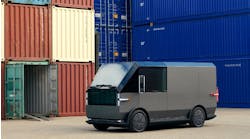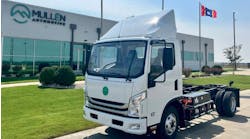Since the first alternative fuel vehicles hit U.S. roads, their relatively reduced driving range has been a significant deterrent to widespread adoption. Studies show that local fleets rarely require vehicles capable of traveling hundreds of miles between refueling events. That aside, the oft-discussed feeling of “range anxiety” takes a toll. What if I need to make an unplanned delivery today? What if I get diverted to a longer route because of traffic conditions?
Today’s drivers are accustomed to vehicles that routinely provide 400- to 750-mi. driving ranges, as gasoline and diesel hold far more energy (per mass and/or volume) than alternative fuels. For example, the fuel tank of a vocational truck holding 65 diesel gals. weighs about 525 lbs., takes up 12 cu. ft. of chassis space, and provides a 450-mi. driving range. No current AFV technology offers such a compelling combination of attributes. For AFVs to stay within weight limits without a major compromise on cargo capacity, range must be reduced.
However, after two decades of AFV experience and a number of key advancements, “range anxiety” is becoming a thing of the past. A few improvements easing this issue include:
- Finding a “sweet spot” between onboard energy and application. To compensate for the lower energy density of alternative fuels, manufacturers have become adept at designing AFVs that better manage inherent trade-offs involving payload, cargo space, cost, refueling time, and driving range. AFVs are now routinely offered with optional onboard energy storage configurations that provide “sweet spots” of driving range for specific duty cycles and operating environments. Even for non-AFV operators, vehicles with unnecessarily large driving ranges are a luxury that comes at a price. Carrying excess fuel is simply inefficient and costly.
- Leveraging the latest technology gains. Battery-electric delivery vehicles are now being offered with at least two options for battery pack kWh ratings. Plug-in hybrid EVs can provide relatively small amounts of all-electric vehicle range for urban areas while also providing petroleum-equivalent range for the open road. Dedicated propane autogas vehicles can be custom-ordered by fleets to optimize performance based on range or cargo space. Natural gas vocational trucks are available with factory-installed composite CNG tanks that hold either 60 or 75 diesel gallon equivalent (DGE). Additionally, fleets are using new software and GPS technology to select driving routes that offer increased fuel efficiency.
- Expanding AFV infrastructure. America’s networks of natural gas (CNG and LNG) and propane autogas stations continue to grow. Networks of faster DC chargers are being deployed to partially charge EVs in about 20 min. EV manufacturers are testing out “battery-swap” options that will greatly alleviate range-related drawbacks of today’s “pure” battery-electric vehicles.
Thanks to all of these developments, today’s AFV purchasers have greater access to configurations in various fuel and technology types that routinely meet their daily driving range needs. Coupled with better logistics and planning, making more with less has gone a very long way to put range anxiety in the rear-view mirror.
Jon Leonard is a senior vice president with Gladstein, Neandross & Associates (GNA), the clean transportation and energy consulting firm that organizes the Alternative Clean Transportation (ACT) Expo. Learn more at www.gladstein.org and www.actexpo.com


